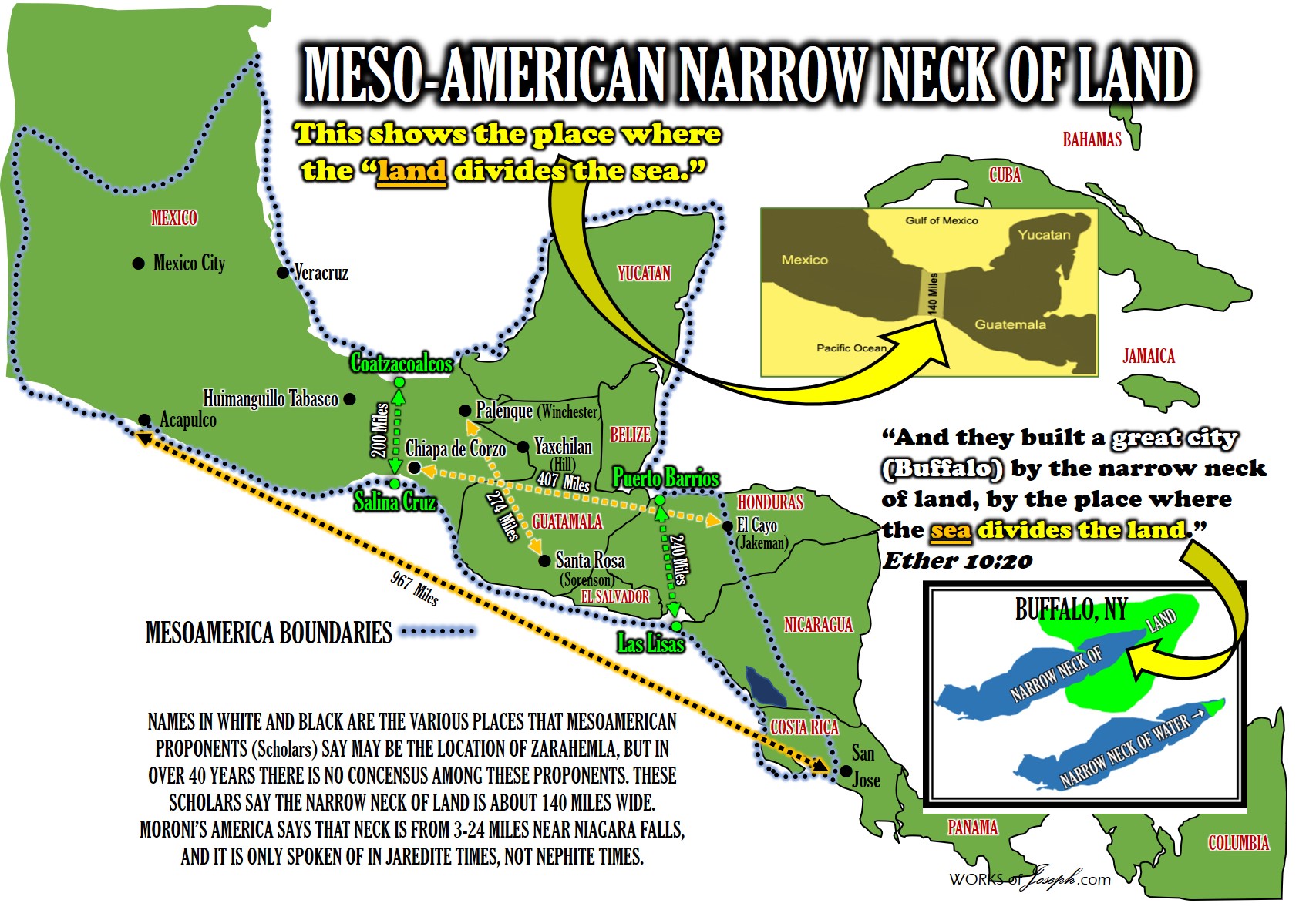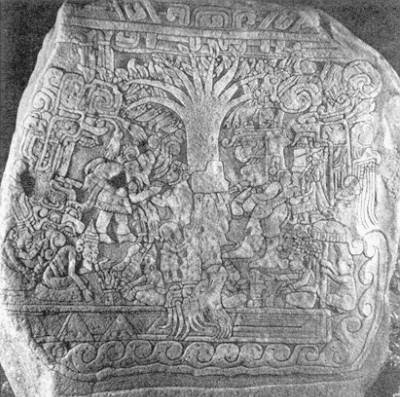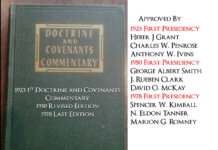What is Limited Geography?
 the Lamanites are, and where they lived, has been a topic of interest for many years in The Church of Jesus Christ of Latter-day Saints. I was taught in the 1970’s what is called the “Hemispheric Model” about the Book of Mormon. (Map Left)
the Lamanites are, and where they lived, has been a topic of interest for many years in The Church of Jesus Christ of Latter-day Saints. I was taught in the 1970’s what is called the “Hemispheric Model” about the Book of Mormon. (Map Left)The reason is, that the distances required to make that old Hemispheric Model a reality has created an almost consensus opinion that it just doesn’t make sense anymore. A “Limited Geography Model” or today what is called (Hinterland Model) is now the consensus.Either the Lehites sailed southwest from Oman and around Africa and they landed in North America near Florida to begin civilization, or they sailed southeast towards the tip of India and through the islands of Malaysia and the Philippines continuing east on the huge Pacific ocean and then landing on the west coast near Chile or Central America. My mariner friend, British Naval Captain Philip Beal from England, estimated this voyage time in a sailing vessel across the Pacific to be 14 to 18 months. Compete Blog here
Did the Inca, Aztec or Mayan civilizations leave any record that they knew about the Book of Mormon peoples? Does any ancient culture of the Americas show any awareness of the Book of Mormon people or events?
By Warren Osborn, Founder at Osborn Companies (1998-present)
Answered February 2, 2019 · Upvoted by Jesse Christopherson, former Mormon Missionary at The Church of Jesus Christ of Latter-day Saints (1996-1998) Source

“As early as 1953, the New World Archaeological Foundation (NWAF) received funding from the Church of Jesus Christ of Latter-day Saints after Thomas Ferguson approached church leaders about finding Book of Mormon archeological evidence. Ferguson had a passion for looking for archaeological evidences for the Book of Mormon and he reminded the church leadership that discovering Book of Mormon artifacts would assist in the church’s missionary program.
After years of studying maps, Mormon scripture, and Spanish chronicles, Ferguson had concluded that the Book of Mormon took place around the Isthmus of Tehuantepec, the narrowest part of Mexico. He had come to the jungles of Campeche, northeast of the isthmus, to find proof.
Ferguson wrote, “It is the only Church on the face of the earth which can be subjected to this kind of investigation and checking.” And in another, to the LDS leadership, he declared, “The Book of Mormon is either fake or fact. If fake, the [ancient] cities described in it are non-existent. If fact—as we know it to be—the cities will be there.”
Below is a map of the land the Ferguson believed to be where the Book of Mormon people’s lived.
After many years of searching for artifacts and other evidence, he came up empty-handed. In 1975, he submitted a paper to a symposium about Book of Mormon geography outlining the failure of archaeologists to find Old World plants, animals, metals, and scripts in Mesoamerica. “The real implication of the paper,” he wrote in a letter the following year, “is that you can’t set Book of Mormon geography down anywhere—because it is fictional.”
In many other excavations and research, the church has come up empty-handed with evidence to back the Book of Mormon. {In Mesoamerica}
- Many animals listed in the Book of Mormon did not exist in the Americas during Book of Mormon history.
- The Book of Mormon tells the details of a war where 2 million were killed. Swords, chariots, cimeters were spoken of as being used. Yet none of these have been found.
- The Book of Mormon speaks of an advanced currency of coins and other metallurgy. None have been found.
- No language matching the Book of Mormon narrative matches.
- Genetic evidence confirms that the people of the Americas originated in Asia, not the Middle East.
- The culture in the Americas during Book of Mormon times does not match the Book of Mormon.
No evidence has been found to date to support the Book of Mormon as real history.
Confirmation of the truth of the book must be found through prayer and by way of the “burning in the bosom.” Source Here:Scroll down to find the article by Warren Osborne.
New World Archaeological Foundation
The New World Archaeological Foundation is an archaeological research and teaching entity administered by the Department of Anthropology at Brigham Young University. The research focus is the study of the origins and subsequent trajectory of civilization (complex societies) in the New World with special emphasis on Mesoamerica. Related to that study is the dissemination of findings through the NWAF Papers and other professional outlets. The NWAF also exists to enrich BYU student experience through mentoring/internship opportunities.
Heartland Model of the Book of Mormon vs. Fantasy Map Theory

The fantasy map from Book of Mormon Central shows the same positioning of the various cities from Lehi’s landing, south, to the Hill Cumorah, north. But only the Heartland map agrees with Ether 10:20 which says, “And they built a great city by the narrow neck of land, by the place where the sea divides the land.” (Not, where the land divides the sea as is shown in the fantasy map).
Lake Ontario and Lake Erie are the seas that divide the land, at the Narrow Neck of Land or the Niagara Peninsula. Native American language says the word “Niagara” means “neck.”

How a Mormon Lawyer Transformed Archaeology in Mexico—and ended up losing his Faith!
By Lizzie Wade Jan. 18, 2018
Thomas Stuart Ferguson lay in his hammock, certain that he had found the promised land. It had been raining for 5 hours in his camp in tropical Mexico on this late January evening in 1948, and his three campmates had long since drifted off to sleep. But Ferguson was vibrating with excitement. Eager to tell someone what he had seen, he dashed through the downpour to retrieve paper from his supply bag. Ensconced in his hammock’s cocoon of mosquito netting, he clicked on his flashlight and began to write a letter home.
“We have discovered a very great city here in the heart of ‘Bountiful’ land,” Ferguson wrote. According to the Book of Mormon, Bountiful was one of the first areas settled by the Nephites, ancient people who supposedly sailed from Israel to the Americas around 600 B.C.E. Centuries later, according to the scripture, Jesus appeared to the Nephites in the same region after his resurrection. Mormons like Ferguson were certain that these events had happened in the ancient Americas, but debates raged over exactly how their sacred lands mapped onto real-world geography. The Book of Mormon gave only scattered clues, speaking of a narrow isthmus, a river called Sidon, and lands to the north and south occupied by the Nephites and their enemies, the Lamanites.
After years of studying maps, Mormon scripture, and Spanish chronicles, Ferguson had concluded that the Book of Mormon took place around the Isthmus of Tehuantepec, the narrowest part of Mexico. He had come to the jungles of Campeche, northeast of the isthmus, to find proof.
As the group’s local guide hacked a path through the undergrowth with his machete, that proof seemed to materialize before Ferguson’s eyes. “We have explored four days and have found eight pyramids and many lesser structures and there are more at every turn,” he wrote of the ruins he and his companions found on the western shore of Laguna de Términos. “Hundreds and possibly several thousand people must have lived here anciently. This site has never been explored before.”
 Thomas Stuart Ferguson L. TOM PERRY SPECIAL COLLECTIONS, HAROLD B. LEE LIBRARY, BRIGHAM YOUNG UNIVERSITY, PROVO, UTAH
Thomas Stuart Ferguson L. TOM PERRY SPECIAL COLLECTIONS, HAROLD B. LEE LIBRARY, BRIGHAM YOUNG UNIVERSITY, PROVO, UTAH
Ferguson, a lawyer by training, did go on to open an important new window on Mesoamerica’s past. His quest eventually spurred expeditions that transformed Mesoamerican archaeology by unearthing traces of the region’s earliest complex societies and exploring an unstudied area that turned out to be a crucial cultural crossroads. Even today, the institute he founded hums with research. But proof of Mormon beliefs eluded him. His mission led him further and further from his faith, eventually sapping him of religious conviction entirely. Ferguson placed his faith in the hands of science, not realizing they were the lion’s jaws.
But that night, lying in his hammock listening to the rain and the occasional roar of a jaguar in the distance, Ferguson felt surer than ever that Mesoamerican civilizations had been founded by migrants from the Near East, just as his religion had taught him. Now, he thought, how would he convince the rest of the world.
The Church of Jesus Christ of Latter-day Saints (LDS) doesn’t take an official position on where the events in the Book of Mormon occurred. But the faithful have been trying to figure it out practically since 1830, when church founder Joseph Smith published what he said was a divinely inspired account of the ancient Americas. Smith said an angel had led him to buried ancient golden plates, which he dug up and translated into the Book of Mormon. Smith’s account of buried wonders was one of many in the United States at the time. As white settlers moved west, they encountered mounds filled with skeletons and artifacts, including beautiful pottery and ornaments. Newspapers, including those in Smith’s hometown of Palmyra, New York, buzzed with speculation about who the “mound builders” were and how they came by their refined culture. Many settlers, blinded by racism, concluded that the mound builders—now known to be indigenous farming societies—were a lost people who had been exterminated by the violent ancestors of Native Americans. The Book of Mormon, with its saga of righteous, white Nephites and wicked, dark-skinned Lamanites, echoed these ideas.
The Book of Mormon also spoke of sprawling ancient cities, none of which had been identified in the United States. So in the 1840s, Mormons, including Smith himself, took notice of a U.S. explorer’s best-selling accounts of visits to the ruins of Mayan cities in Mexico and Guatemala. In 1842, as editor of a Mormon newspaper, Smith published excerpts from a book about the ruins of the Mayan city of Palenque in Mexico, with the commentary: “Even the most credulous cannot doubt … these wonderful ruins of Palenque are among the mighty works of the Nephites—and the mystery is solved.”
But non-Mormons continued to doubt, and church authorities gradually retreated from explicit statements about Book of Mormon locations. By the 1930s, when Ferguson learned about Mesoamerican civilizations as an undergraduate at the University of California (UC), Berkeley, the matter had been largely ceded to amateurs who pored over maps and the Book of Mormon looking for correspondences.
Ferguson wasn’t impressed by their efforts. “The interested and inquiring mind of the modern investigator is not satisfied with explanations which are vague, unsound, and illogical,” he wrote in an article in a church magazine in 1941. By then he was a law student at UC Berkeley and intrigued by the idea of scientifically testing Smith’s revelation. In a later letter, he wrote, “It is the only Church on the face of the earth which can be subjected to this kind of investigation and checking.” And in another, to the LDS leadership, he declared, “The Book of Mormon is either fake or fact. If fake, the [ancient] cities described in it are non-existent. If fact—as we know it to be—the cities will be there….
In 1954, LDS authorities granted NWAF $250,000 for 5 years of work. Intensive excavations at Chiapa de Corzo uncovered stone pyramids and tombs, and a wealth of pottery that impressed University of Pennsylvania anthropologist John Alden Mason, then working with NWAF. “Since pre-Classic pottery is not very common anywhere, and that of this region is entirely new, it is of course a very great scientific contribution,” Mason wrote to Ferguson. Eventually, archaeologists reported that the site was settled around 1200 B.C.E., likely by people connected to the Olmec, an early civilization that dominated the gulf coast of Mexico from 1200 B.C.E. to 400 B.C.E., centuries before the Classic Maya arose.

Then, in the early 1960s, NWAF archaeologists became the first to extensively excavate at Izapa, near the Chiapas coast and the Guatemalan border. They were drawn to the site in part because of a monument that apparently depicts a myth involving a tree; Ferguson’s friend and founder of BYU’s archaeology department, M. Wells Jakeman, argued that the carving shows visions received in a dream by the Mormon prophet Lehi. NWAF archaeologists, some of whom were Mormon, later soundly rebuffed that interpretation. But Izapa turned out to be a key site in the Soconusco, the Pacific coast region from which every Mesoamerican political power, from the Olmec in 1200 B.C.E. to the Aztec empire in the early 1500s C.E., sourced key luxury goods such as cacao and quetzal feathers. NWAF spearheaded excavations throughout this region. Pottery finds and dates from Izapa and elsewhere formed the basis of the ceramic chronologies for the Formative period that are still used by every archaeologist working in central and coastal Chiapas today.
“They were working in a part of Mesoamerica that was really unknown,” says Michael Coe, an influential Mesoamerican archaeologist and professor emeritus at Yale University who, at the time, was surveying Formative sites just over the border in Guatemala. “NWAF put it on the map.”
But even as NWAF grew in scientific stature, and was finally assured continued existence when BYU took it over in 1961, Ferguson was quietly becoming frustrated. The smoking gun he had been certain he would find—Egyptian or Hebrew script—proved elusive. He once had promised that archaeological evidence for the Book of Mormon would be found within 10 years of NWAF starting excavations. But in 1966 he wrote, “My number one goal of establishing that Christ appeared in Mexico following the crucifixion will never be achieved until significant ancient manuscript discoveries are made. I hope it happens during our lifetimes.”
When an ancient manuscript discovery did come, however, it was from a different quarter of the world—and it shook Ferguson’s faith to its core.
In the summer of 1835, Joseph Smith had received a curious visitor in Kirtland, Ohio, then the headquarters of his burgeoning LDS church: a traveling showman, with four Egyptian mummies and some hieroglyphic texts in tow. The church bought the mummies and texts, and Smith said he translated the hieroglyphics, resulting in the Book of Abraham, which lays out Smith’s cosmic vision of the afterlife. (Although Egyptian hieroglyphics had been deciphered in France in 1822 with the help of the Rosetta Stone, the news had barely reached U.S. shores.) As Smith and his followers moved around the Midwest, often fleeing angry mobs, they carried the mummies and papyri with them. After Smith’s death at the hands of one of those mobs in Nauvoo, Illinois, they were sold by his family…
After decades of stressing the importance of the scientific method and using it to shore up his own faith, Ferguson now found himself at its mercy. “I must conclude that Joseph Smith had not the remotest skill in things Egyptian-hieroglyphics,” he wrote to a fellow doubting Mormon in 1971. What’s more, he wrote to another, “Right now I am inclined to think that all of those who claim to be ‘prophets’, including Moses, were without a means of communication with deity.”
This doubt ultimately spread to Ferguson’s archaeological quest. In 1975, he submitted a paper to a symposium about Book of Mormon geography outlining the failure of archaeologists to find Old World plants, animals, metals, and scripts in Mesoamerica. “The real implication of the paper,” he wrote in a letter the following year, “is that you can’t set Book of Mormon geography down anywhere—because it is fictional.”
Although open about his doubts in his private letters, Ferguson didn’t discuss his loss of faith with his family. He continued attending church, singing in the choir, and even giving blessings. “[Mormons] are so immersed in that culture … [that] to lose your faith, it’s like you’re being expelled from Eden,” Coe says. “I felt sorry for him.” Complete article and video here
Thomas Stuart Ferguson – Mormon Handbook
Son of Thomas Ferguson
Rod Meldrum’s good friend is the son of Thomas Ferguson. This friend of Rod’s is a very strong believer in the Heartland Model and wished his father would have been around when all of these discoveries of Wayne May’s and Rod Meldrum’s information had come to light.
I am continually amazed at the lack of desire for some prominent archaeologists in the Church to begin explorations in the Heartland of North America. Wayne May continues to search for the City of Zarahemla as do other members of the Church. If the Lord desires, more evidence will be found.
A Treasure Trove of North American Evidence of the Book of Mormon
Final Battles at Cumorah- Verified Archaeology Nearby
Nephite Fruits in North America- Mounds, Artifacts, Armor, & Steel Swords in Plain Sight
Hebrew Evidence in North America
Tennessee Egyptian Temple & Amazing GA/TN Archaeology
Many Nephite Artifacts in North America-Not Hoaxes




